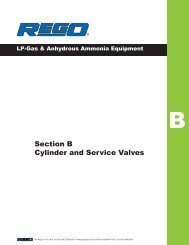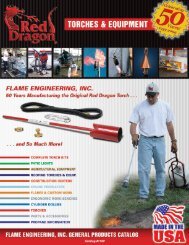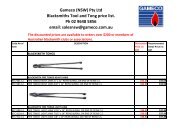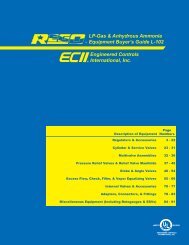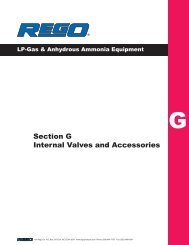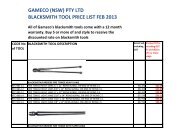Repair Kits Available By Part Number Section 2 Page - GAMECO
Repair Kits Available By Part Number Section 2 Page - GAMECO
Repair Kits Available By Part Number Section 2 Page - GAMECO
Create successful ePaper yourself
Turn your PDF publications into a flip-book with our unique Google optimized e-Paper software.
1. Lubricate existing outer stem bearing, new stem O-ring and assemble<br />
into seal gland.<br />
2. Lubricate new dust seal and press fit into seal gland.<br />
3. Lubricate and place the (3) new stem seals, new jam ring and new<br />
stem washer into seal gland. Place new stem spring into seal gland.<br />
4. Carefully thread the entire rebuilt seal gland assembly over stem and<br />
into valve body.<br />
CAUTION: Use special care in replacing seal gland assembly.<br />
Excessive force could cut resilient parts.<br />
5. Install the appropriate actuator onto valve.<br />
Manual Actuator:<br />
a. Install lever on stem and align holes.<br />
b. Secure with cotter pin.<br />
Pneumatic Actuator Installation:<br />
NOTE: Lubricant compound 11550-215, or the equivalent,<br />
should be applied in a light coating when specified. Torque<br />
tolerance is +/- 10 lbs. Refer to Diagram 2 during assembly of<br />
the pneumatic actuator.<br />
a. Remove the clevis and clevis locknut from the air chamber shaft.<br />
Remove cotter pin and pivot pin from the clevis.<br />
b. Assemble the air chamber to the bracket using the air chamber<br />
nuts and lock washers. Center the air chamber shaft in the<br />
clearance hole of the bracket. Tighten air chamber nuts to 375<br />
in/lbs.<br />
c. Reassemble the clevis locknut and clevis to the air chamber<br />
shaft. Adjust the clevis so that the center of the pivot pin hole is<br />
2 3 /4" from the bracket with the pivot pin holes in the horizontal<br />
plane. Lock the clevis in place with the clevis locknut using 200<br />
in/lbs torque.<br />
d. Mount the above bracket assembly to the valve face with the<br />
bracket screws and lock washers. Be sure that the top of the<br />
bracket is even with the upper edge of the valve face and<br />
centered around the hex of the packing gland. Torque the<br />
bracket screws to 60 in/lbs.<br />
e. Assemble the crank arm onto the valve stem so that the crank<br />
arm leg clears the clevis legs. Rotate the crank arm so the leg<br />
positions itself between the legs of the clevis. Align cotter pin<br />
holes and secure with the cotter pin. Spread and bend the ends<br />
of the pin back onto the hub.<br />
f. Assemble the two pivot pin washers onto the pivot pin. Lubricate<br />
the pivot pin shaft and assemble through the holes of the clevis<br />
legs and crank arm leg. The air chamber shaft can be displaced<br />
manually along with movement of the crank arm to effect<br />
alignment. Once the pivot pin is engaged, check to see that the<br />
crank arm leg is at approximately 35 ° to the vertical. If bench<br />
assembled, the cam should be horizontal, or slightly below<br />
horizontal, and the clearance between the cam and the end of<br />
the poppet should measure 3 /16" + /- 1 /64".<br />
Should an adjustment be necessary, follow these procedures:<br />
i) Remove the pivot pin and pivot pin washers.<br />
ii) Rotate the crank arm counterclockwise until the leg clears the<br />
clevis.<br />
iii)Loosen the clevis locknut and adjust the clevis appropriately,<br />
in or out. A half a turn of the clevis changes the angle<br />
approximately 3 /4 degree, or the cam/poppet clearance by<br />
.010".<br />
iv)Reassemble the pivot pin and the pivot pin washers. Check<br />
again for proper angle/clearance. Once correct, lock the<br />
clevis in place with the clevis locknut.<br />
v) Assemble the cotter pin into the pivot pin hole. Spread and<br />
turn back the cotter pin legs around the pivot pin shaft.<br />
Functional Testing<br />
Connect a 50 to 60 psig air line through a pressure regulated valve to the<br />
actuator.<br />
Bench Testing<br />
Slowly and alternately apply 0 to 35 psig air pressure to the actuator two<br />
or three times while checking for binding and any interference. Make any<br />
necessary adjustments so the actuator opens freely . Be sure the<br />
actuator shaft bottoms out on the actuator housing at full stroke and not<br />
within the valve.<br />
Installed Testing<br />
Same as the bench test, except a higher air pressure may be necessary<br />
if tank pressure is present.<br />
Diagram — 2<br />
A3217F Internal Valve<br />
Bracket Lockwashers (4)<br />
Bracket Screws (4)<br />
Air Chamber<br />
Bracket<br />
Clevis Cotter Pin<br />
Valve Face<br />
Packing Gland<br />
Valve Stem<br />
Air Chamber Nuts (2)<br />
Air Chamber Lockwashers (2)<br />
Nylon<br />
Washer<br />
Cotter Pin<br />
Crank Arm<br />
Pivot Pin Washer<br />
Clevis<br />
Locknut<br />
Clevis<br />
Pivot Pin



